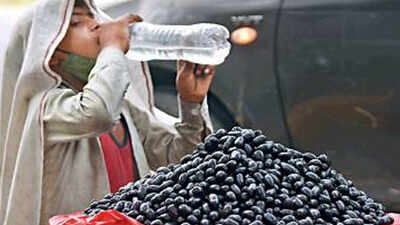Top Searches
- News
- City News
- delhi News
- The heat is on: On Thursday, Delhi recorded hottest July day in 9 years
The heat is on: On Thursday, Delhi recorded hottest July day in 9 years

A boy selling jamun tries to cool off with the mercury shooting past 43°C.
NEW DELHI: The city recorded the hottest July day since 2012 with the mercury rising to 43.1°C, six degrees above normal, at the base observatory in Safdarjung on Thursday. Mungeshpur was the hottest area in Delhi at 45.2°C, followed by Pitampura at 44.3°C and Najafgarh (44°C).
Track the pollution level in your city
On July 2, 2012, the temperature had shot up to 43.5°C.
Thursday was the third consecutive day when a heatwave gripped the city. Some parts even reeled under a ‘severe heatwave’. In a relief of sorts, a few areas received a drizzle late at night.
Heatwave conditions are likely to continue at isolated places on Friday, though there are chances of dust storms and thunderstorms accompanied by very light rain or gusty winds in the evening or night. There is a possibility of very light rain on Saturday as well.
Lack of rain, no cloud cover and hot and dry winds blowing from Rajasthan have led to the relentless heatwave and rise in temperature in the capital. Kuldeep Srivastava, IMD scientist and head, Regional Weather Forecasting Centre, said the city recorded a heatwave in July after seven years. The last time four heatwaves swept the city in a year was in 2014.
The westerly winds also led to ‘poor’ air quality and rise of pollution in the capital.
Dust to be lead pollutant for next three days
Delhi’s overall Air Quality Index (AQI) was recorded at 266. System of Air Quality and Weather Forecasting And Research (SAFAR), the forecasting body under the Union ministry of earth sciences, said, "Surface winds are high and westerly, and are likely to stay high for the next 24 hours. Dust blowing from far-flung dry and arid regions along with local emissions are expected to continue in the coming days. Dust (PM10) will be the lead pollutant for the next three days.”
The IMD defines a heatwave day when the maximum is 4.5°C and more above the normal temperature and the maximum is at least 40°C. A heatwave is also declared if the maximum touches 45°C or above. A ‘severe heatwave’ is declared when the maximum is 6.5°C or more above normal.
Track the pollution level in your city
On July 2, 2012, the temperature had shot up to 43.5°C.
Thursday was the third consecutive day when a heatwave gripped the city. Some parts even reeled under a ‘severe heatwave’. In a relief of sorts, a few areas received a drizzle late at night.
Heatwave conditions are likely to continue at isolated places on Friday, though there are chances of dust storms and thunderstorms accompanied by very light rain or gusty winds in the evening or night. There is a possibility of very light rain on Saturday as well.
Lack of rain, no cloud cover and hot and dry winds blowing from Rajasthan have led to the relentless heatwave and rise in temperature in the capital. Kuldeep Srivastava, IMD scientist and head, Regional Weather Forecasting Centre, said the city recorded a heatwave in July after seven years. The last time four heatwaves swept the city in a year was in 2014.
The westerly winds also led to ‘poor’ air quality and rise of pollution in the capital.
Dust to be lead pollutant for next three days
Delhi’s overall Air Quality Index (AQI) was recorded at 266. System of Air Quality and Weather Forecasting And Research (SAFAR), the forecasting body under the Union ministry of earth sciences, said, "Surface winds are high and westerly, and are likely to stay high for the next 24 hours. Dust blowing from far-flung dry and arid regions along with local emissions are expected to continue in the coming days. Dust (PM10) will be the lead pollutant for the next three days.”
The IMD defines a heatwave day when the maximum is 4.5°C and more above the normal temperature and the maximum is at least 40°C. A heatwave is also declared if the maximum touches 45°C or above. A ‘severe heatwave’ is declared when the maximum is 6.5°C or more above normal.
FacebookTwitterLinkedinEMail
Start a Conversation
end of article
